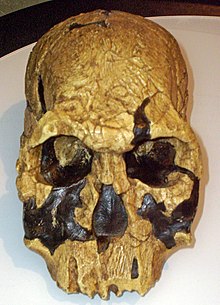Homo rudolfensis
extinct species of hominins marking the boundary between Australopiths and Homo erectus
| Homo rudolfensis Temporal range: Pliocene
| |
|---|---|

| |
| Scientific classification | |
| Kingdom: | |
| Phylum: | |
| Class: | |
| Order: | |
| Family: | |
| Genus: | |
| Species: | H. rudolfensis
|
| Binomial name | |
| †Homo rudolfensis Alexeev, 1986
| |
Homo rudolfensis is a fossil hominin species discovered by Bernard Ngeneo, a member of a team led by anthropologist Richard Leakey and zoologist Meave Leakey in 1972, at Koobi Fora on the east side of Lake Rudolf (now Lake Turkana) in Kenya. The scientific name Homo rudolfensis was proposed in 1986 by V. P. Alexeev for the specimen Skull 1470 (KNM ER 1470). Skull 1470 has an estimated age of 1.9 million years.[1]

References
change- ↑ Strait, D.; Grine, F.; Fleagle, J. G. (2015). "Analyzing Hominin Hominin Phylogeny: Cladistic Approach" (PDF). In Henke, W.; Tattersall, I. (eds.). Handbook of Paleoanthropology (2nd ed.). Springer. p. 2006. doi:10.1007/978-3-642-39979-4_58. ISBN 978-3-642-39979-4. Archived from the original (PDF) on 2020-06-12. Retrieved 2020-06-15.